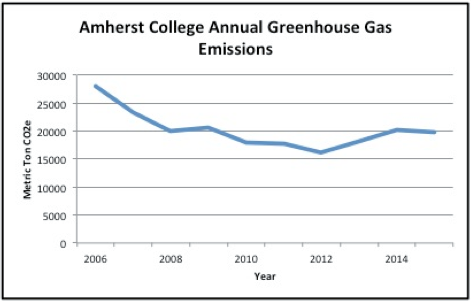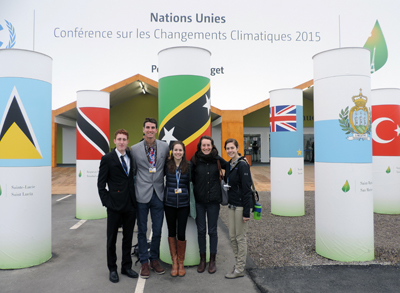Amherst formed the Office of Environmental Sustainability (OES) in October 2014 with a vision to “fulfill the College’s moral obligation to incorporate environmental awareness and practices into the daily lives of students, so they will be equipped to shape the environment they live in through their actions and leadership.” Today, the OES is a focal point and catalyst for awareness-building, collaboration and action on sustainability issues across campus. The following highlights some of our activities and initiatives to date.
Climate

Climate change is a defining issue of our time. Amherst has taken significant steps in the past decade to reduce its greenhouse gas emissions, including switching to lower-carbon fuel sources; adding a co-generation plant to more efficiently create heat and electricity from these fuel sources; following a high-performance standard in the design and construction of new buildings; and retrofitting existing buildings to make them more energy-efficient. These actions have resulted in a 30-percent reduction in emissions from 2006 levels.
To further reduce our emissions, we are now working to set quantitative greenhouse gas reduction targets. In January 2015, we formed a broadly representational task force to support our office in recommending a Climate Action and Implementation Plan. That task force, with the help of an external consultant, is modeling our current greenhouse gas emissions and analyzing new ways in which the College might reduce its climate impact, including by helping us to identify a clear path towards carbon neutrality.

First-year students learn about solar panels in the Solving Climate Change LEAP program.
The February 2015 announcement from the College’s Board of Trustees on the Sustainability and Investment Policy reinforces the importance of this work. We plan to consult with the campus community, seniors leaders and the Board of Trustees to finalize our plan by the end of 2016. Among other recommendations, the plan will identify methods for making new and existing buildings energy-efficient, and methods for using renewably generated electricity. This plan will identify specific goals, timelines and associated metrics that we will track over time and report on annually. The plan will also be designed to grow and improve with improving knowledge. Continuous student engagement throughout the development and implementation of this plan will provide critical learning opportunities.
Campus Operations

Amherst and Pomona students at COP 21 in Paris.
Amherst has long focused on efficiency and conservation in its campus operations. This focus will only grow as we move forward with the Climate Action and Implementation Plan. As one way to support this plan, OES will partner with students interested in operational improvements, thus making the campus a living laboratory that embeds educational value into its daily operation. Students may, for example, conduct statistical analyses of energy metering data, develop sustainability-related apps for fellow students and help write materials that teach fellow students about the innovative features of our new dorms and science center. Furthermore, OES will continue to help identify, implement and support operational improvements that provide sustainable and financial benefits to the College, such as renewable-energy hedges (financial agreements between the College and generators of renewable energy) and a green revolving fund that would support energy-efficient retrofits of existing buildings.
Student Empowerment and Engagement
With the formation of the OES, students who were already working hard to make the College more sustainable can now turn to our staff for administrative support. Additionally, the OES has helped to launch several student-led projects, including AC Bike Share, Green Athletics, the Trash-to-Fashion Show, the Food Waste Initiative and the Eco-Rep Program. These are succeeding in reaching a wide cross-section of the student body.
Education

Amherst students in the Trash-to-Fashion Show
The OES has participated in several environmental studies courses, teaching students about lifecycle assessment—a technique for assessing the total environmental impact of any particular product—and equipping them with energy meters to test and analyze the energy use of common dorm room items. OES also organized an orientation LEAP program, “Solving Climate Change,” in which students toured renewable energy facilities and held a mock UN climate negotiation. In addition, OES co-facilitated a special topics course on the 2015 Paris climate negotiations. Three students attended the negotiations, and the class worked to engage and educate the campus community on this historic event.
Food
Amherst College Dining Services is continually focused on providing real, fresh and local food. Among other efforts, Dining Services has increased the amount of fresh vegetables it procured by more than 50 percent since 2010, has converted to using cage-free eggs and local protein whenever possible, and is purchasing all milk from the Berkshire-based High Lawn Farm.
Perhaps the biggest transformation has been the addition of produce from Book & Plow, an independent farm located on College land with strong ties to the students and campus community. Book & Plow employs dozens of students each season to help with the cultivation and harvesting of food that they and their peers then enjoy in the dining hall. The farm also provides educational and community building experiences, whether in partnering with professors for lessons on organic farm practices, hosting trivia nights with the “Friends of Book & Plow” student group, or providing pumpkins for carving in the Campus Center.

Students harvest vegetables on the Book & Plow Farm
In our ongoing work to “develop exemplary approaches to environmental, financial and institutional sustainability,” we will continue to foster an inclusive, positive, innovative approach to sustainable action. We will also find new ways to measure and track our progress, including by submitting a report in the coming year to the Sustainability, Assessment & Rating System. And we will continue to work closely with our greatest resource, Amherst students, connecting them with faculty, staff and community members to explore, pilot and launch new, innovative programs, and supporting them as they grow into the leaders they desire to be in creating a just and sustainable society.
December 2015